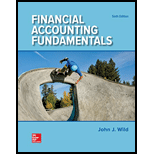
1.
Identify the maturity date for each of the three notes described.
1.
Explanation of Solution
Notes payable:
Notes Payable is a written promise to pay a certain amount on a future date, with certain percentage of interest. Companies use to issue notes payable to meet short-term financing needs.
Maturity date:
The date on which the borrower should pay the principal amount of loan, or bond, is referred to as maturity date.
| Particulars | Company L | Bank NBR | Bank F |
| Date of note | 19th May | 8th July | 28th November |
| Terms of the note ( in days) | 90 | 120 | 60 |
| Maturity date | 17th August | 5th November | 27th January |
(Table 1)
2.
Identify the interest due at maturity for each of the three notes.
2.
Explanation of Solution
Calculate the interest due at maturity for the note bearing an amount of $35,000.
Therefore, the interest due at maturity for the note bearing an amount of $35,000 is $875.
Calculate the interest due at maturity for the note bearing an amount of $80,000.
Therefore, the interest due at maturity for the note bearing an amount of $80,000 is $2,400.
Calculate the interest due at maturity for the note bearing an amount of $42,000.
Therefore, the interest due at maturity for the note bearing an amount of $42,000 is $560.
3.
Identify the interest expense to be recorded in the
3.
Explanation of Solution
Therefore, the interest expense recorded in the adjusting entry at the end of 2016 is $308.
4.
Identify the interest expense to be recorded in 2017.
4.
Explanation of Solution
Therefore, the interest expense recorded in 2017 is $252.
Prepare
Explanation of Solution
| Date | Account title and Explanation | Debit in $ | Credit in $ |
| April 20, 2016 | Merchandise inventory | 40,250 | |
| Accounts payable to Company L | 40,250 | ||
| (To record the purchase of merchandise on credit) | |||
| May 19 | Accounts payable to Company L | 40,250 | |
| Cash | 5,250 | ||
| Notes payable-Company L | 35,000 | ||
| (Paid $5,250 cash and gave a 90-day, 10% note to extend due date on account) | |||
| July 8 | Cash | 80,000 | |
| Notes payable –Bank NBR | 80,000 | ||
| (Borrowed cash with a 120-day, 9% note.) | |||
| August 17 | Interest expense | 875 | |
| Notes payable –Company L | 35,000 | ||
| Cash | 35,875 | ||
| (Paid note with interest.) | |||
| November 5 | Interest expense | 2,400 | |
| Notes payable –Bank NBR | 80,000 | ||
| Cash | 82,400 | ||
| (Paid note with interest.) | |||
| November 28 | Cash | 42,000 | |
| Notes payable –Bank F | 42,000 | ||
| (Borrowed cash with 60-day, 8% note.) | |||
| December 31 | Interest expense | 308 | |
| Interest payable | 308 | ||
| (Accrued interest on note payable.) | |||
| January 27, 2017 | Interest expense | 252 | |
| Notes payable- Bank F | 42,000 | ||
| Interest payable | 308 | ||
| Cash | 42,560 | ||
| (Paid note with interest.) |
(Table 2)
Want to see more full solutions like this?
Chapter 9 Solutions
Financial Accounting Fundamentals
- Please provide the solution to this general accounting question with accurate financial calculations.arrow_forwardNonearrow_forwardWhich of the following is true about the Inland Revenue Authority’s Power to Audit? The audit is conducted on a random basis in most cases Notice is normally done by a telephone call followed by a written notice The taxpayer must respond to the notice, within a specified time In Jamaica, the taxpayer must be given 24 hours notice of the intended audit. A.i and ii B.ii and iii C.All of the above D.i, ii and iiiarrow_forward
- Calculate Net salesarrow_forwardCan you help me solve this general accounting problem using the correct accounting process?arrow_forwardWhich of the following about capital allowances is not true: A.Initial allowance is deducted from the cost to the asset to arrive at its tax written down value (TWDV). B.Annual Allowances are given each year provided the asset is in use at the end of the tax year. C.For industrial buildings, initial allowance is only given on construction, alteration of industrial buildings (not purchased). D.Initial Allowance can be deferred. It can be claimed in the year following when the expenditure was incurred.arrow_forward
- A company has current assets that could be sold for their book value of $30 million. The book value of its fixed assets is $80 million, but they could be sold for $120 million today. The company has total debt with a book value of $50 million, but interest rate changes have caused the market value of the debt to increase to $60 million. What is the ratio of the market value of equity to its book value?arrow_forwardI am searching for a clear explanation of this financial accounting problem with valid methods.arrow_forwardI need guidance with this general accounting problem using the right accounting principles.arrow_forward

 AccountingAccountingISBN:9781337272094Author:WARREN, Carl S., Reeve, James M., Duchac, Jonathan E.Publisher:Cengage Learning,
AccountingAccountingISBN:9781337272094Author:WARREN, Carl S., Reeve, James M., Duchac, Jonathan E.Publisher:Cengage Learning, Accounting Information SystemsAccountingISBN:9781337619202Author:Hall, James A.Publisher:Cengage Learning,
Accounting Information SystemsAccountingISBN:9781337619202Author:Hall, James A.Publisher:Cengage Learning, Horngren's Cost Accounting: A Managerial Emphasis...AccountingISBN:9780134475585Author:Srikant M. Datar, Madhav V. RajanPublisher:PEARSON
Horngren's Cost Accounting: A Managerial Emphasis...AccountingISBN:9780134475585Author:Srikant M. Datar, Madhav V. RajanPublisher:PEARSON Intermediate AccountingAccountingISBN:9781259722660Author:J. David Spiceland, Mark W. Nelson, Wayne M ThomasPublisher:McGraw-Hill Education
Intermediate AccountingAccountingISBN:9781259722660Author:J. David Spiceland, Mark W. Nelson, Wayne M ThomasPublisher:McGraw-Hill Education Financial and Managerial AccountingAccountingISBN:9781259726705Author:John J Wild, Ken W. Shaw, Barbara Chiappetta Fundamental Accounting PrinciplesPublisher:McGraw-Hill Education
Financial and Managerial AccountingAccountingISBN:9781259726705Author:John J Wild, Ken W. Shaw, Barbara Chiappetta Fundamental Accounting PrinciplesPublisher:McGraw-Hill Education





